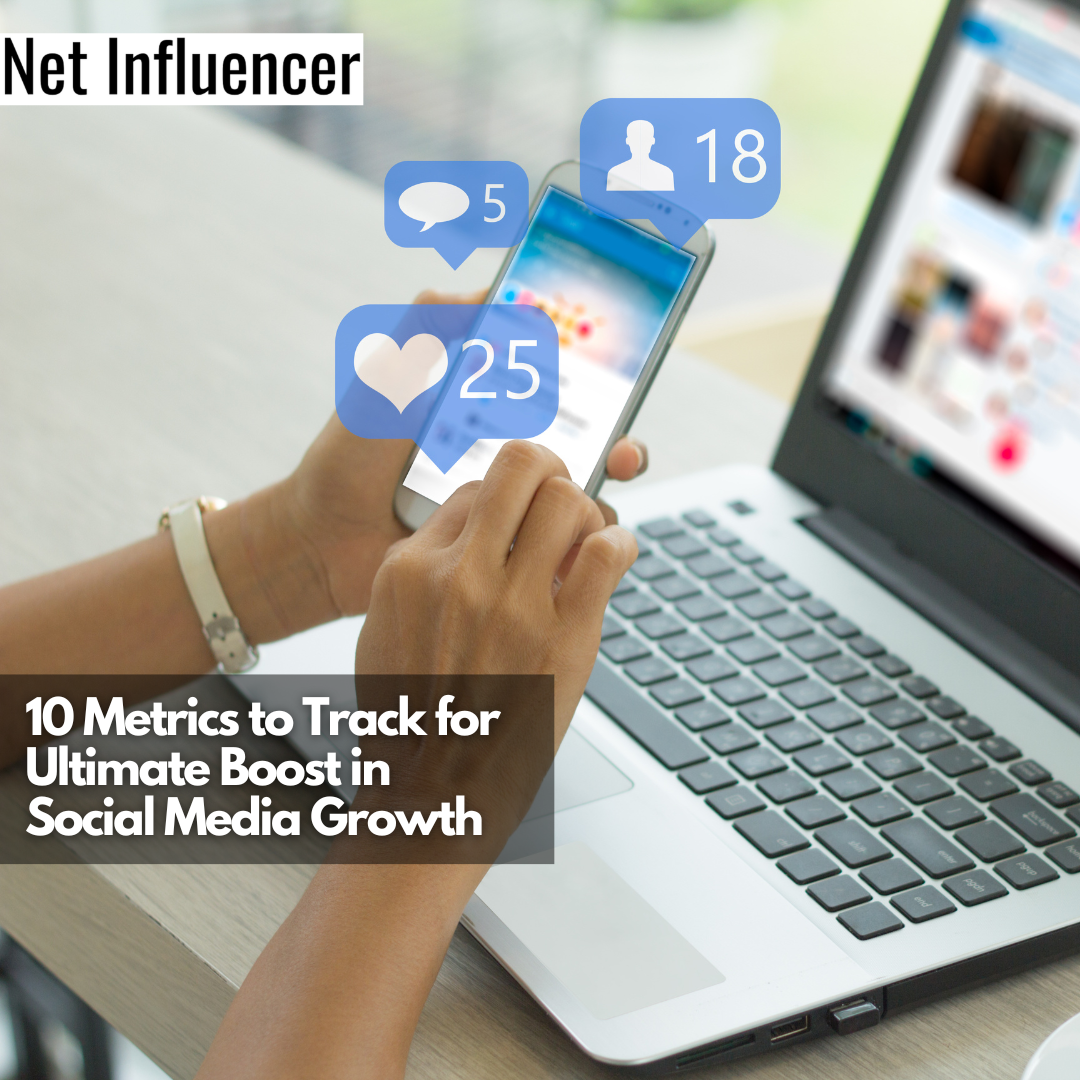Strategy
Metrics to Track for Social Media Growth
Social media is everywhere. It has penetrated even the micro-spaces in our everyday life. The number of social media platform users is projected to grow from 4.26 billion in 2021 to a whopping 6 billion in 2027! So guess what’s likely to come with that increase? That’s right—along with it is the massive potential to shape our beliefs, thoughts, and behaviors, including buying decisions and habits.

This is why any forward-thinking business knows that having a social media strategy is crucial to marketing success. And like any strategy worth executing, you must know when it delivers results. Not sure how to measure social media metrics? In this post, we’ll share ten metrics by which you can track your performance for the ultimate boost in social media growth.
What are social media metrics?
Social media metrics are quantitative measures by which you evaluate the performance of your social media marketing efforts against predetermined standards. These give you critical insights into how customers perceive and respond to your brand. Your choice of which yardsticks to use will depend on your goals, your company’s needs, the length of your campaigns, your budget, and other factors.
Why are social media metrics important?
How essential are social media metrics? Here’s a rundown of some of the top reasons why tracking social media metrics is critical to your business growth.
1. They help define what your goals are.
Social media metrics help you be more concrete about your end goals. They get you to focus on what matters to you, enabling you to plan and measure for success.
2. They enable you to find out what works and what doesn’t.
Determining your performance in several social media metrics gives a fairly accurate picture of how well your social media strategy is working. At the same time, it guides you to where you should invest your precious company resources, be it on fixing weaknesses, further boosting your strengths, or ditching digital marketing moves that are no longer relevant.
3. They help you take your business to the next level of growth.
Social media metrics also help you identify real business opportunities and distinguish these from mere distractions. When you’re constantly checking your performance, you also get to compare your strategies to the industry’s best practices. This helps you stay ahead of the competition.
10 metrics to track for the ultimate boost in social media growth
Check out these top social media metrics for the ultimate boost in your social media growth.
Awareness metrics
These social media metrics tell you how many people are aware of your brand.
1. Reach
This pertains to how many people get to see the content you post on social media. The three main types of reach are organic, paid, and viral (which is how many check out your content because of its interactions with other users, either by sharing or reacting to it). Subsets are individual metrics like post reach, video reach, and story reach. Find out your reach by checking using apps like Brand24.
2. Impressions
This social media metric indicates the number of times someone sees your content on their online news feeds (which can be more than once). For marketing professionals who are planning marketing campaigns, they make a forecast of the number of impressions. So they calculate using this formula: Impressions = Cost/ (CPM x 1,000). Cost refers to the promotional cost of paid advertising. The CPM (cost per mile) is computed by dividing your advertising costs by the projected number of impressions. Once actual impressions are available, use these to obtain the real score on this awareness metric.
Engagement metrics
These social media metrics determine how connected you are to your audience. Engaged customers or followers are “in a relationship” with your brand, which they express through frequent interactions. Here are some engagement metrics to measure yourself with:

3. Post-engagement rate
This refers to the number of people who interact with you after seeing your post. To get this, divide the number of engagements (likes, comments, re-tweets, etc.) by the number of impressions or reach score.
4. Account mentions
This is a measure of the number of times your brand has been mentioned organically on social media platforms without prompting. To track this, you can use social media monitoring tools like BrandMentions.
Video metrics
Brands use video metrics like the ones below to assess the performance of their video content.
5. Video views
This shows how many people have clicked on your video to see it.
6. Video completion rate
This video metric is more effective in evaluating video performance because it tells you how many viewers have completely watched the video and actually connected with your content.
Customer experience and service metrics
Do you care for your customers? These social media metrics will tell you how customers experience your brand and how satisfied they are with the support you provide. Some valuable customer experience and service metrics to check out are:
7. Net promoter score (NPS)
This metric gauges brand loyalty on a scale of 1 to 10 by asking customers how likely they are to recommend the product or service to a friend. They’re classified as detractors (scores of 0 to 6), passives (scores of 7 to 8), and promoters (scores of 9 to 10). To compute this metric, subtract the number of detractors from the number of promoters and divide by the total number of respondents. Then, multiply by 100 to get your NPS.
8. Customer lifetime value
This customer experience and service metric tells you the worth of a customer to your business over the entire course of their relationship with your brand. This is calculated by multiplying the annual profit contribution of the customer by the number of years that they remain your customer. Then deduct the initial cost of acquiring the customer. Customer acquisition costs investments in customer service, advertising, and product manufacturing over a given time frame.
Consideration metrics
These social media metrics are used to track the effectiveness of your content at the consideration phase. This is the part of the marketing funnel where potential customers have already narrowed their choices to a “consideration set,” products or services that are seen as viable options for the individuals’ problems or needs. Two significant consideration metrics are:
9. Audience engagement
This measures the time the customer spends on a page on your website, which indicates their interest.
10. Click-through rate (CTA)
Click-through rates show how many people follow through by clicking on your ads after seeing them. Compute this metric by dividing your ad’s number of clicks by the number of times it’s shown (clicks/impressions).
How to create a social media plan
A social media plan is necessary for you to be able to optimize your content strategy and direction. Here’s a simple guide to creating one:
- Set your SMART goals (specific, measurable, achievable, relevant, and time-bound). The more detailed your objectives are, the better you will be able to fine-tune your social media metrics.
- Audit your site or account (assess your present performance and position, including your strengths and weaknesses).
- Leverage the insights of your customers to find out what drives them (these will help you determine what key metrics to go for).
- Learn from the competition (benchmarking your content versus that of successful brands will tell you what metrics and content strategies work for them, which you can apply to your own brand).
- Optimize your social media profile (make it visually consistent across all socmed platforms and use the most relevant keywords).
- Curate catchy and unique content (one way to do this is by tapping user-generated content to find out what’s trending).
- Stay organized with a social media calendar.
- Track your performance with social media metrics.
- Keep on learning and improving!
How do you track social media growth?
The socmed metrics we’ve just shared can help you track your social media growth. But where do you get the numbers to compute your performance scores?
Earlier, we provided some formulas to secure the data you need to calculate your metrics. However, we would like to recommend using social media tracking tools (which we’ve also mentioned ahead of this section) that can simplify and expedite the process for you.

Social media analytics tools, such as Google Analytics, Twitter Analytics, and Meta Business Suite, can provide comprehensive data and give you access to invaluable insights. You may also use innovative apps like Hootsuite to help you create customized report templates for free.
Wrap up
By using these 10 social media metrics, you can effectively track your social media growth. The key is to work smarter and not harder by utilizing analytics tools that can help you understand where you’re at and what areas you still need to imporove on. Keep these tips to heart and take your business to the next level.




















